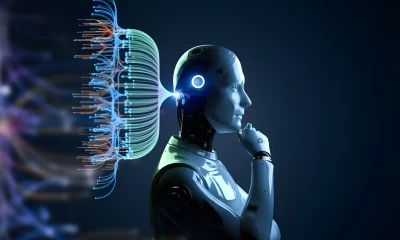Artificial Intelligence
Unlearning Copyrighted Data From a Trained LLM – Is It Possible?

In the domains of artificial intelligence (AI) and machine learning (ML), large language models (LLMs) showcase both achievements and challenges. Trained on vast textual datasets, LLM models encapsulate human language and knowledge.
Yet their ability to absorb and mimic human understanding presents legal, ethical, and technological challenges. Moreover, the massive datasets powering LLMs may harbor toxic material, copyrighted texts, inaccuracies, or personal data.
Making LLMs forget selected data has become a pressing issue to ensure legal compliance and ethical responsibility.
Let's explore the concept of making LLMs unlearn copyrighted data to address a fundamental question: Is it possible?
Why is LLM Unlearning Needed?
LLMs often contain disputed data, including copyrighted data. Having such data in LLMs poses legal challenges related to private information, biased information, copyright data, and false or harmful elements.
Hence, unlearning is essential to guarantee that LLMs adhere to privacy regulations and comply with copyright laws, promoting responsible and ethical LLMs.

However, extracting copyrighted content from the vast knowledge these models have acquired is challenging. Here are some unlearning techniques that can help address this problem:
- Data filtering: It involves systematically identifying and removing copyrighted elements, noisy or biased data, from the model's training data. However, filtering can lead to the potential loss of valuable non-copyrighted information during the filtering process.
- Gradient methods: These methods adjust the model's parameters based on the loss function's gradient, addressing the copyrighted data issue in ML models. However, adjustments may adversely affect the model's overall performance on non-copyrighted data.
- In-context unlearning: This technique efficiently eliminates the impact of specific training points on the model by updating its parameters without affecting unrelated knowledge. However, the method faces limitations in achieving precise unlearning, especially with large models, and its effectiveness requires further evaluation.
These techniques are resource-intensive and time-consuming, making them difficult to implement.
Case Studies
To understand the significance of LLM unlearning, these real-world cases highlight how companies are swarming with legal challenges concerning large language models (LLMs) and copyrighted data.
OpenAI Lawsuits: OpenAI, a prominent AI company, has been hit by numerous lawsuits over LLMs’ training data. These legal actions question the utilization of copyrighted material in LLM training. Also, they have triggered inquiries into the mechanisms models employ to secure permission for each copyrighted work integrated into their training process.
Sarah Silverman Lawsuit: The Sarah Silverman case involves an allegation that the ChatGPT model generated summaries of her books without authorization. This legal action underscores the important issues regarding the future of AI and copyrighted data.
Updating legal frameworks to align with technological progress ensures responsible and legal utilization of AI models. Moreover, the research community must address these challenges comprehensively to make LLMs ethical and fair.
Traditional LLM Unlearning Techniques
LLM unlearning is like separating specific ingredients from a complex recipe, ensuring that only the desired components contribute to the final dish. Traditional LLM unlearning techniques, like fine-tuning with curated data and re-training, lack straightforward mechanisms for removing copyrighted data.
Their broad-brush approach often proves inefficient and resource-intensive for the sophisticated task of selective unlearning as they require extensive retraining.
While these traditional methods can adjust the model's parameters, they struggle to precisely target copyrighted content, risking unintentional data loss and suboptimal compliance.
Consequently, the limitations of traditional techniques and robust solutions require experimentation with alternative unlearning techniques.
Novel Technique: Unlearning a Subset of Training Data
The Microsoft research paper introduces a groundbreaking technique for unlearning copyrighted data in LLMs. Focusing on the example of the Llama2-7b model and Harry Potter books, the method involves three core components to make LLM forget the world of Harry Potter. These components include:
- Reinforced model identification: Creating a reinforced model involves fine-tuning target data (e.g., Harry Potter) to strengthen its knowledge of the content to be unlearned.
- Replacing idiosyncratic expressions: Unique Harry Potter expressions in the target data are replaced with generic ones, facilitating a more generalized understanding.
- Fine-tuning on alternative predictions: The baseline model undergoes fine-tuning based on these alternative predictions. Basically, it effectively deletes the original text from its memory when confronted with relevant context.
Although the Microsoft technique is in the early stage and may have limitations, it represents a promising advancement toward more powerful, ethical, and adaptable LLMs.
The Outcome of The Novel Technique
The innovative method to make LLMs forget copyrighted data presented in the Microsoft research paper is a step toward responsible and ethical models.
The novel technique involves erasing Harry Potter-related content from Meta's Llama2-7b model, known to have been trained on the “books3” dataset containing copyrighted works. Notably, the model's original responses demonstrated an intricate understanding of J.K. Rowling's universe, even with generic prompts.
However, Microsoft's proposed technique significantly transformed its responses. Here are examples of prompts showcasing the notable differences between the original Llama2-7b model and the fine-tuned version.

This table illustrates that the fine-tuned unlearning models maintain their performance across different benchmarks (such as Hellaswag, Winogrande, piqa, boolq, and arc).

The evaluation method, relying on model prompts and subsequent response analysis, proves effective but may overlook more intricate, adversarial information extraction methods.
While the technique is promising, further research is required for refinement and expansion, particularly in addressing broader unlearning tasks within LLMs.
Novel Unlearning Technique Challenges
While Microsoft's unlearning technique shows promise, several AI copyright challenges and constraints exist.
Key limitations and areas for enhancement encompass:
- Leaks of copyright information: The method may not entirely mitigate the risk of copyright information leaks, as the model might retain some knowledge of the target content during the fine-tuning process.
- Evaluation of various datasets: To gauge effectiveness, the technique must undergo additional evaluation across diverse datasets, as the initial experiment focused solely on the Harry Potter books.
- Scalability: Testing on larger datasets and more intricate language models is imperative to assess the technique's applicability and adaptability in real-world scenarios.
The rise in AI-related legal cases, particularly copyright lawsuits targeting LLMs, highlights the need for clear guidelines. Promising developments, like the unlearning method proposed by Microsoft, pave a path toward ethical, legal, and responsible AI.
Don't miss out on the latest news and analysis in AI and ML – visit unite.ai today.














